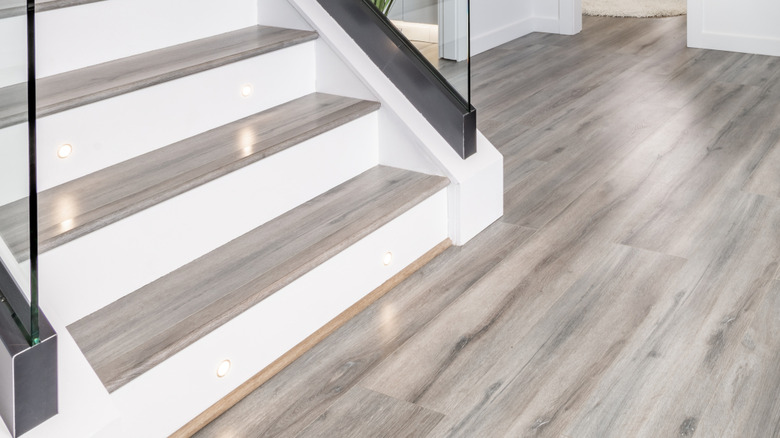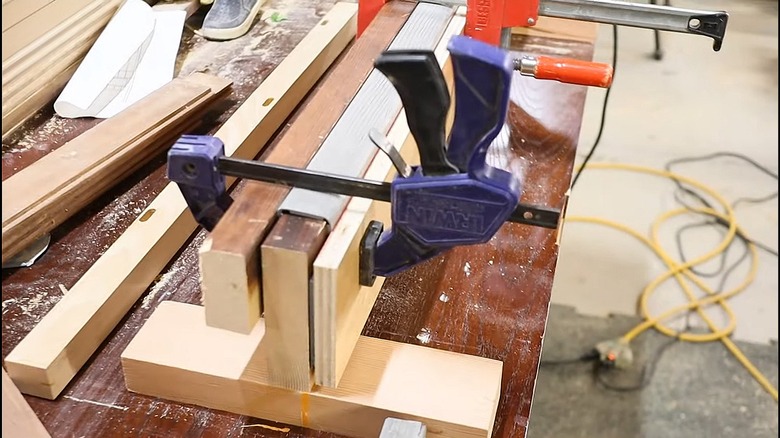The Amazing Hack To Make Your Stair Treads Match Your LVP Floor
We may receive a commission on purchases made from links.
No, really, it's not the end of the world: Your stair treads don't have to match your luxury vinyl plank (LVP) flooring. Guests will barely notice, and you'll get used to the mismatch after a decade or so. This is the fate Instagram influencer Jess Davis (@carcabaroad) was facing until her flooring team told her they could make treads and nosings that match her LVP flooring. She danced a little jig down her gorgeous new stairs, sharing it all to Instagram.
The treads are not the problem, of course; they're just flat bits of floor. It's the nosings — the part at the front of the tread that often sticks out a bit, that become an issue. Treads are often shaped from solid wood, but LVP isn't nearly thick enough to mill. So her installers cut two channels in the backing layers of the flooring, heated it using a device (two actually, side-by-side) designed to heat acrylic for bending, then formed the pliable planks into nosings using a wooden jig.
But what about if you're doing a DIY install? You might get lucky and find nosings that match your floor, though they can add a lot to the cost of installing a vinyl plank floor. Or you could buy two Home & Garden 48-inch acrylic bender elements from Amazon for about $190 each, and you might need four if your stairs are wider than the standard 36-48 inches. LVP planks themselves are typically 36-60 inches long, and some are as long as 72 inches, but it's really the stair tread width that matters. How about a simple, inexpensive alternative? Grab a heat gun and some boards and get to hacking.
DIY bullnose and rounded nosings using a heat gun
If you're not up for buying an acrylic bender or attempting to make your own, you can try a process perfected by a number of DIYers: Use a heat gun and a couple of boards. You can pick up a Genesis GHG1500A dual temperature heat gun with appropriately wide nozzle attachments for under $30, and probably do the rest with scrap wood. For the classic rounded bullnose profile that can improve the appearance of any room (or rounded variants with a bit less overhang), the process is straightforward. Use something like a router with a straight bit or oscillating saw to remove about half of the plank's thickness from the backing side, where you want the bend to happen.
Build yourself a clamping jig by sandwiching an LVP plank between a bit of traditional wood nosing (you can make your own with a roundover router bit) and another board. Slip your LVP plank into the groove so it rests against the sandwiched piece. Set your heat gun to full blast and heat the back of the vinyl slowly and evenly as you bend it over the wood nosing form. After it's bent partway over, you will have to heat the wear layer side of the LVP, applying heat just past the previous bend. Clamp the LVP with F-clamps and a spacer board to avoid having the clamps make direct contact with the vinyl. Then just measure each stair (or use a tread-measuring jig) and rip a piece of LVP for the back of the tread to mate with the bullnose section of plank, gluing it all down.
DIY square tread nosings with a heat gun
More modern square-profile stair nosings require an only slightly more complicated process to bend. Rather than routing one big channel in the back of your LVP, you'll make two using a couple of passes on a table saw (or one pass, if you're using a dado stack) to make narrower relief cuts. The goal is to get two bends closer to right angles, rather than one larger curve. The grooves will also allow you to make smaller-radius bends without cracking the wear side. The centers of your two relief cuts should be spaced equal to the thickness of your tread nosing, and each should be about ⅜ inch wide for most flooring.
For your bending jig, rather than using a piece of bullnose, you'll need a bit of plywood or a board that's the thickness of your stair tread (under the LVP) and at least the width of your stairs. Again, sandwich a piece of LVP between this board and another board of the same length, making sure to leave a recess the depth of your bend setback. This notch will hold the LVP planks perfectly while you're heating and bending them. After getting a plank nice and hot with your heat gun (longer heating usually results in less cracking and splitting), clamp it with a third board on the tread side so the LVP holds its shape as it cools.
Don't be shy. Just as updating your stair treads is easier than you think, so is making your own LVP stair nosings. With a little up-front setup, the process should go smoothly and save you a fortune.

